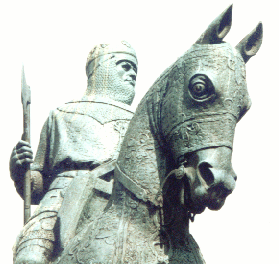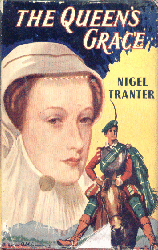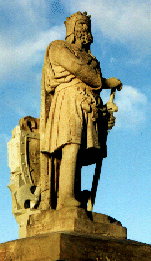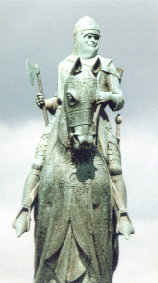

![]()
![]()
![]()
 |
.
Cameron, after making a marvellous job of my story of the Battle of Byland Moor, asked me to write this foreword to introduce it. At first I was dubious about doing this and, in fact, left it on the back burner so to speak. However, since then, I have become aware of more information from this period and have even read some of the papers (in translation) written at the time and these have now been incorporated into the text. In researching this paper I have also found myself following in the spectral footsteps of 'the master himself'.
Indeed I owe a debt of gratitude to Nigel for awakening in me a deep love and passion for our Country's history. My first schooldays in the Highlands had history lessons of course, but they were English history lessons. At the age of seven I knew that Henry VIII had six wives. 'Divorced, beheaded, she died, divorced, beheaded, survived.' Belted into me by miss MacKinnon's nine strap lochgelly tawse. Nothing was taught in school regarding Scottish history, let alone Gaelic history. This was left to my grandparents and mother to instil into me.
 Then, back in 1966, I was lying in hospital in Singapore when the WRVS lady came round with the library trolley and, because I was getting tired of reading the westerns and James Bonds, I selected 'The Queens Grace' by Nigel. After three chapters I was hooked. Never had history been so interesting and so painless. Thank you Nigel!
Then, back in 1966, I was lying in hospital in Singapore when the WRVS lady came round with the library trolley and, because I was getting tired of reading the westerns and James Bonds, I selected 'The Queens Grace' by Nigel. After three chapters I was hooked. Never had history been so interesting and so painless. Thank you Nigel!
Nigel must have corresponded copiously with a number of eminent historians and academics in his researches and one such was the late Agnes Mure MacKenzie who died in 1955. In the list of people who consulted her works posthumously from 1962 onwards was a certain N. Tranter!
Nigel also must have made a point of visiting each location of any historical event to get the setting just right. He stayed at the 'Hambleton Hotel' whilst researching Byland moor and one old barman told me that he remembered Mr Tranter very well, as his knowledge of ENGLISH History confounded all the local history pundits! That I can well believe. Where Nigel and I differ, is in the detail. Detail gets in the way of the flow of a good story, whereas I like the little details that give life to what would be otherwise grey boring facts just like our schooldays.
For example, Nigel mentions the murder of Abbot William Peebles and his monks at Melrose Abbey in the passing. I expanded this a little more and now after consulting the MacKenzie papers a story of heroic self sacrifice is revealed as you will later read.
To answer that question, I would like to take you back some 700 years and let you meet King Robert the Bruce. A Man acknowledged by Historians to have been Scotland's own Alexander the Great for his high degree of skill in tactics and strategy. Yet to be the finest strategist and tactician does not automatically make one a good leader, so let us examine some aspects of Bruce's Life and demeanour to establish what it was that made him so special, so loved by his Men, that they would cheerfully follow him through the Moloch fires of Hell itself if he so wished it.
The Scots are a difficult people to lead successfully. The Scots character is such as it will only respond to personal leadership and close contact. Where there was mutual affection and involvement with the Men not Orders and demands for discipline. Two Years before Bannockburn, Bruce was besieging the Castle on Loch Doon and he personally led the raiding party that scaled the walls and opened the gate for his besiegers to capture the castle. Sir Gilbert Hay remonstrated with Bruce and the Bruce replied, 'It must be I who Lead, since only I know what I would effect. Moreover, I do not ask others to do what I will not myself do. You know that.' Later He led the successful assault on Perth and captured the Water Gate so that Perth fell to the Scots army.
The Scottish chiefs and landowners were accustomed to fighting alongside their men and Bruce made it his normal policy to do the same. The English leaders meanwhile retained their aloofness from their men. The class system of English society carried over to the battlefield. The English nobles would never deign to fight alongside "lesser mortals" and as such were kept remote from those on whom their battles depended. Like many great leaders in history who preceded and followed Bruce, he gained the trust and confidence of his army. They were willing to fight and die for him to uphold his honour and the cause for which they were now preparing.'
A more recent parallel was the British retreats in Malaya, Burma, Singapore and the East Indies before the victorious Japanese army. The Japanese were regarded as invincible jungle fighters when in fact they were not. They just had better leaders. The British army was largely officered by people from the ruling and landed classes and most of them were 'well meaning useless duffers' to quote my tutor at the RAF Staff College.
Another e-mail from another old member mentioned finding arrow heads and brass horse harness buckles which are now lodged in the local museum at Thirsk as well as York. Many of the snippets do have a human interest aspect and cast light into what would be otherwise dark corners. I imagine if Nigel were writing the Bruce trilogy now, with all this information He would never have got it finished. We must be thankful indeed that Nigel did write the Bruce trilogy, which, after Columba, I regard as his finest writings.
Now let us travel back in time to 1322, to the scene of the greatest disaster for English arms on English soil and also King Robert the Bruce's greatest triumph.
Byland Moor 1322
 Other letters reveal how morale was low because the men knew their top leaders were incompetent buffoons and they knew the Scots were led by fearsome and talented leaders who never knew defeat. This was true. The Scottish army was cock a hoop over its successes, they trusted The Bruce and his lieutenants to give them victory against any odds and because of this they regarded themselves as invincible victors. This is a short piece I wrote on Bruce's leadership: 'What is leadership?
Other letters reveal how morale was low because the men knew their top leaders were incompetent buffoons and they knew the Scots were led by fearsome and talented leaders who never knew defeat. This was true. The Scottish army was cock a hoop over its successes, they trusted The Bruce and his lieutenants to give them victory against any odds and because of this they regarded themselves as invincible victors. This is a short piece I wrote on Bruce's leadership: 'What is leadership?
 One of the advantages Bruce had over the English was his relationship with the humble foot soldier. Bruce took great pains to make himself known to all his men, He would visit them as they sat round their campfires, exchange jokes, encourage His men to do their best in the forthcoming battles. It should be noted that Bruce could speak at least four languages Norman French, Latin, English and Gaidhlig. Maybe he also spoke in the scots vernacular as well.
One of the advantages Bruce had over the English was his relationship with the humble foot soldier. Bruce took great pains to make himself known to all his men, He would visit them as they sat round their campfires, exchange jokes, encourage His men to do their best in the forthcoming battles. It should be noted that Bruce could speak at least four languages Norman French, Latin, English and Gaidhlig. Maybe he also spoke in the scots vernacular as well.
 I have received some highly informative facts from e-mails and correspondence. One old member of the Yorkshire Gliding Club told me, that when they were clearing the site, they uncovered the foundations of several houses near Roulston Scar. It transpires that the English Soldiers under the Earl of Richmond, demolished these houses to provide rocks to hurl down on the Scots.
I have received some highly informative facts from e-mails and correspondence. One old member of the Yorkshire Gliding Club told me, that when they were clearing the site, they uncovered the foundations of several houses near Roulston Scar. It transpires that the English Soldiers under the Earl of Richmond, demolished these houses to provide rocks to hurl down on the Scots.
CONTINUE TO THE STORY OF BYLAND MOOR

RETURN TO
